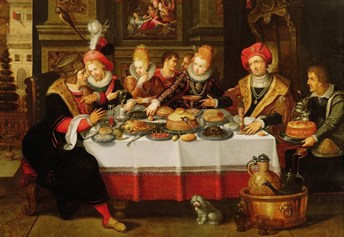Food and the table in high society
 Compared to the middle and lower level of the population, the European aristocracy and the new emerging groups composed of nobles, wealthy merchants and political and economic elites could afford the highest and most costly standards, or which simply denoted a different taste and were considered chic or exclusive. The consumption of fowl, which was mentioned earlier with regards to the spread of turkeys in Europe, declined during the Early Modern age, eclipsed, among the higher social groups, by meat from butchers. The decrease in the consumption of bread, while the rest of the population was mainly fed with wheat and other types of cereal, was offset by the increasing demand for vegetables, especially in Italy: artichokes, asparagus, peas, mushrooms, truffles, vegetables, carrots, lettuce, watercress, cucumber, green beans, pumpkins and many others. Fruit, especially in the seventeenth century, became a distinctive feature of more affluent European tables: whole or in salads, raw or cooked, in the form of jam, jelly or candied, fruits concluded banquets in high society and were considered the dessert par excellence. Not surprisingly, between the seventeenth and eighteenth century, the nobility and the upper middle class of Europe developed a real passion for gardens, vegetable gardens and orchards.
Compared to the middle and lower level of the population, the European aristocracy and the new emerging groups composed of nobles, wealthy merchants and political and economic elites could afford the highest and most costly standards, or which simply denoted a different taste and were considered chic or exclusive. The consumption of fowl, which was mentioned earlier with regards to the spread of turkeys in Europe, declined during the Early Modern age, eclipsed, among the higher social groups, by meat from butchers. The decrease in the consumption of bread, while the rest of the population was mainly fed with wheat and other types of cereal, was offset by the increasing demand for vegetables, especially in Italy: artichokes, asparagus, peas, mushrooms, truffles, vegetables, carrots, lettuce, watercress, cucumber, green beans, pumpkins and many others. Fruit, especially in the seventeenth century, became a distinctive feature of more affluent European tables: whole or in salads, raw or cooked, in the form of jam, jelly or candied, fruits concluded banquets in high society and were considered the dessert par excellence. Not surprisingly, between the seventeenth and eighteenth century, the nobility and the upper middle class of Europe developed a real passion for gardens, vegetable gardens and orchards.
More generally, European cuisine in the Early Modern period experienced new tastes: after the elimination of many spices and tastes which were more bitter and strong, it was enhanced by the presence of food with more delicate flavour, like vegetables, but also dairy products. The harmony of flavours, the search for foods that were pleasing to the palate, the sense of taste to be applied not only to the arts, fashion or furnishings, but also to food and how to serve it constituted significant new elements for the European gentleman, coincidentally also referred to as a “man of taste.”
Great importance was also given to how to serve the table, to present the various courses and to eating. There are several differences compared to the present day in the distribution of food among the various courses, a sign of a contrast between sweet and salty that European society would acquire only in the nineteenth century. Hence figs, melon and blackberries were served with salt in the hors d’oeuvres or antipasto, which in the dessert were placed alongside fruit, olives, artichokes, truffles and various types of cheese and in general meals alternated dishes which were sweet and salty. In addition, the Early Modern era saw the introduction of elements which have remained constant up to the present day: the introduction of the fork (in Italy as early as the fourteenth century, then in neighboring countries during the sixteenth and seventeenth centuries), the creation of a dining room for the consumption of meals (but this was mainly in the eighteenth century) and the end of unhampered conviviality i.e. the appearance of table spoons, knives and individual glasses as opposed to the medieval habit of dishes which were used in common during banquets. Finally, according to the social class to which they belong to, other rules varied from region to region, such as those relative to meal times, the order in which the guests were served, the provision of food and drinks on the tables and the use of different types of seasonings. From this point of view, the main divide between the cuisine of the Mediterranean countries and Northern ones was the use of oil or butter. (image: Gaspar Van den Hoecke, The banquet).
